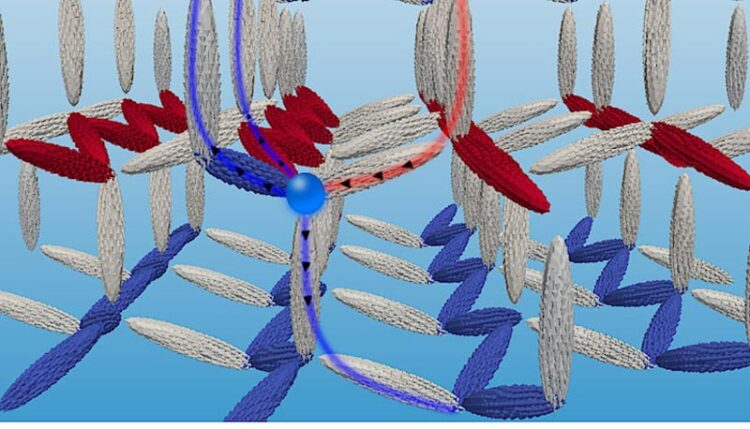Emergent magnetic monopoles controlled at room temperature

Researchers at the University of Vienna have designed a new 3D magnetic nanonetwork, where magnetic monopoles emerge due to rising magnetic frustration among the nanoelements, and are stable at room temperature.
Credit: © Sabri Koraltan University of Vienna (License CC BY-NC-ND)
Emergent magnetic monopoles are observed in a class of magnetic materials called spin ices. However, the atomic scales and required low temperatures for their stability limit their controllability. This led to the development of 2D artificial spin ice, where the single atomic moments are replaced by magnetic nano-islands arranged on different lattices.
The up-scaling allowed the study of emergent magnetic monopoles on more accessible platforms. Reversing the magnetic orientation of specific nano-islands propagates the monopoles one vertex further, leaving a trace behind. This trace, Dirac Strings, necessarily stores energy and bind the monopoles, limiting their mobility.
Researchers around Sabri Koraltan and Florian Slanovc, and led by Dieter Suess at the University of Vienna, have now designed a first 3D artificial spin ice lattice that combines the advantages of both atomic- and 2D artificial spin ices.
In a cooperation with Nanomagnetism and Magnonics group from University of Vienna, and Theoretical Division of Los Alamos Laboratory, USA, the benefits of the new lattice are studied employing micromagnetic simulations. Here, flat 2D nano-islands are replaced by magnetic rotational ellipsoids, and a high symmetry three-dimensional lattice is used. “Due to the degeneracy of the ground state the tension of the Dirac strings vanish unbinding the magnetic monopoles”, remarks Sabri Koraltan, one of the first-authors of the study. The researchers took the study further to the next step, where in their simulations one magnetic monopole was propagated through the lattice by applying external magnetic fields, demonstrating its application as information carriers in a 3D magnetic nano-network.
Sabri Koraltan adds “We make use of the third dimension and high symmetry in the new lattice to unbind the magnetic monopoles, and move them in desired directions, almost like true electrons”. The other first-author Florian Slanovc concludes, “The thermal stability of the monopoles around room temperature and above could lay the foundation for ground breaking new generation of 3D storage techonologies”.
Publication in npj Computational Materials:
Koraltan, S., Slanovc, F., Bruckner, F. et al. Tension-free Dirac strings and steered magnetic charges in 3D artificial spin ice. npj Comput Mater 7, 125 (2021). https://doi.org/10.1038/s41524-021-00593-7
Journal: npj Computational Materials
DOI: 10.1038/s41524-021-00593-7
Subject of Research: Not applicable
Article Title: Tension-free Dirac strings and steered magnetic charges in 3D artificial spin ice
Article Publication Date: 4-Aug-2021
Media Contact
Veronika Schallhart
presse@univie.ac.at
Office: +43-1-4277-175 30
All latest news from the category: Physics and Astronomy
This area deals with the fundamental laws and building blocks of nature and how they interact, the properties and the behavior of matter, and research into space and time and their structures.
innovations-report provides in-depth reports and articles on subjects such as astrophysics, laser technologies, nuclear, quantum, particle and solid-state physics, nanotechnologies, planetary research and findings (Mars, Venus) and developments related to the Hubble Telescope.
Newest articles

Pinpointing hydrogen isotopes in titanium hydride nanofilms
Although it is the smallest and lightest atom, hydrogen can have a big impact by infiltrating other materials and affecting their properties, such as superconductivity and metal-insulator-transitions. Now, researchers from…

A new way of entangling light and sound
For a wide variety of emerging quantum technologies, such as secure quantum communications and quantum computing, quantum entanglement is a prerequisite. Scientists at the Max-Planck-Institute for the Science of Light…

Telescope for NASA’s Roman Mission complete, delivered to Goddard
NASA’s Nancy Grace Roman Space Telescope is one giant step closer to unlocking the mysteries of the universe. The mission has now received its final major delivery: the Optical Telescope…



